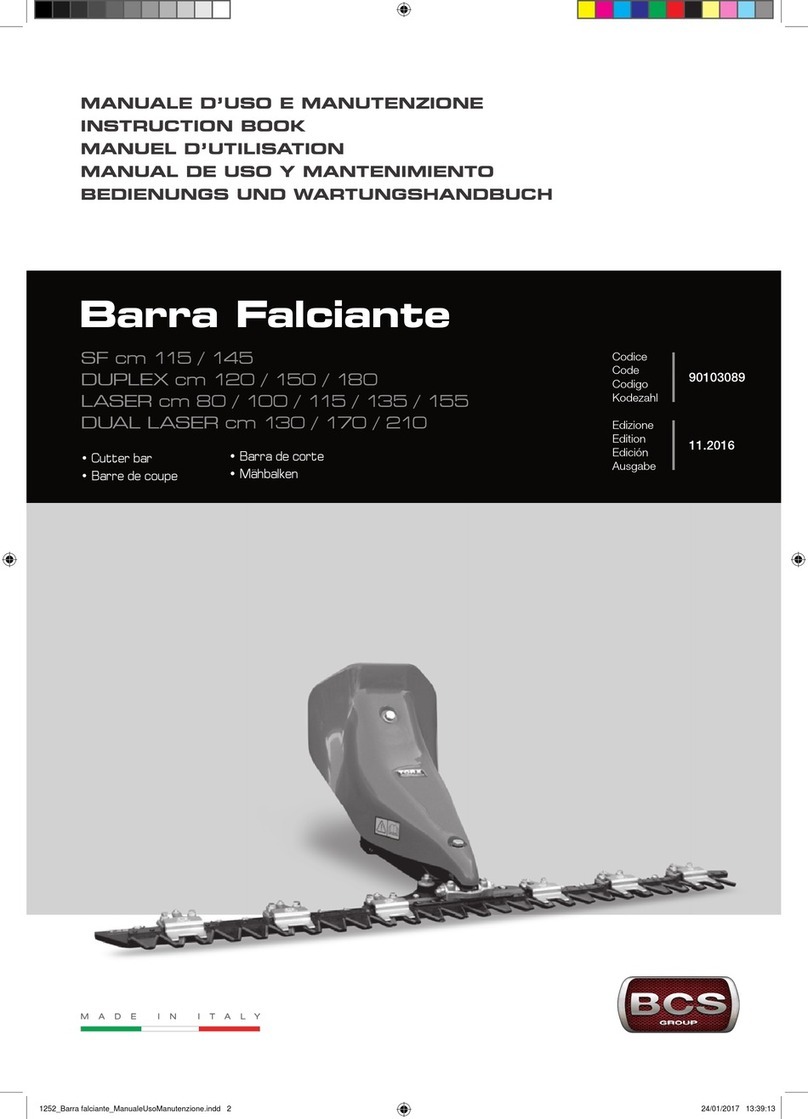
6
MONTAGGIO
I
Fare attenzione che il perno entri nella sua sede quindi
montare la barra falciante Bal gruppo comando Acon i
due dadi e le rondelle (fig.5) e serrare forte.
N.B. Per il montaggio del gruppo falciante “Duplex Bilama”
(a doppia manovella) prestare attenzione che entrambi i
perni Fe G entrino nella loro sede (fig.5b), quindi proce-
dere come detto sopra.
SE E’ NECESSARIO FARE UN TAGLIO DELL’ERBA AL-
TO, PROCEDERE COME SEGUE: montare le slitte di re-
golazione altezza di taglio Csulla barra falciante con le viti
in dotazione (fig.6) se si deve tagliare normalmente è pre-
feribile non montarle. Per tagliare vicino a muri o piante è
bene montare le protezioni laterali D. FARE ATTENZIONE
che la protezione sia accostata al dente (fig.7).
La barra “Duplex Bilama” non ha né protezioni laterali, né
slitte di regolazione.
Per montare la protezione laterale sulla barra Europa
da 0,80:
•
svitare e togliere il premilama E(fig.8);
•
posizionare la protezione laterale e fissarla con le viti in
dotazione (fig.9).
ASSEMBLY
GB
Verify that the stud seats properly in its housing, then
mount the cutting bar Bto control panel Aby the two nuts
and washers (fig.5) and tighten hardly.
N.B. For the assembly of the “Duplex Double Blade” mo-
wing group (with a double crank mechanism), make certain
both pins Fand Gfit into their housings (fig.5b), then
proceed as described above.
IF NECESSARY CUT HIGH: install the cutting height ad-
justment slides Con the cutter bar using the bolts provided
(fig.6), if a normal cut has to be performed it is advisable
not to mount them. Tu cut near walls or trees, fit the
optional side protection D. MAKE SURE that the protector
fits flush against the outer tooth (fig.7).
The “Duplex Double Blade” bar has neither lateral pro-
tections nor adjustment carriages.
To fit the side protection on the 30” Europa cutter bar:
•
remove the blade holder E(fig.8);
•
position the side protection and fasten it with the bolts
supplied (fig.9).
MONT
GE
F
Vérifier que le pivot entre dans son siège, monter la barre
de coupe Bau groupe de commande Aavec les deux
ecrous et les rondelles (fig.5) et serrer fortement.
N.B. Pour le montage du groupe faucheur “Duplex Bilame”
(à double manivelle), il faut faire très attention que les deux
pivots Fet Gentrent dans leur emplacement (fig.5b), par
conséquent il faut procéder selon la description ci-dessus.
SI NECESSAIRE COUPER HAUT: monter les traineaux
réglage de la hauter de coupe Csur la barre de coupe
avec les vis (fig.6); si on doit couper normalement, il est
préférable de ne pas les monter. Pour couper près de
murs ou plantes il est bien de monter les protections
latérales D. ATTENTION: la protection doit être approchée
au dent (fig. 7). La barre “Duplex Bilame” n’a ni protections
latérales, ni glissières de réglage.
Pour monter la protection latérale sur la barre Europa
de 0,80 mt:
•
dévisser et ôter le presse-lame E(fig.8);
•
positionner la protection latérale et fixer-la avec les vis
délivrées (fig.9).
MONTAJE
E
Observar que el perno entre en su alojamiento, luego
montar la barra de corte Bal grupo mando Acon las dos
tuercas y las arandelas (fig.5) y atornillar fuertemente.
Nota: para el montaje del grupo de siega “Duplex Bilama”
(de doble manivela) hay que tener la precaución de que
los dos pernos Fy Gentren en su sitio (fig.5b) y hacer lo
que se menciona más arriba.
SI SE NECESITA CORTAR ALTO: montar los patines de
regulación de altura de corte Csobre la barra de corte, con
los tornillos de la dotación (fig.6), si se debe cortar normal-
mente es preferible no montarlos. Para el corte cerca los
muros o plantas es aconsejable montar las protecciónes
laterales D. PONER ATENCIÓN que la protección esté
arrimada al diente (fig.7).
La barra “Duplex Bilama” no tiene ni protecciones laterales
ni guías de regulación.
Para montar la protección lateral en la barra de 0,80
Europa:
•
destornillar y sacar la guia cuchilla E(fig.8);
•
colocar la protección lateral y fijarla con los tornillos de
dotacion (fig.9).
MONTAGE
D
Prüfen, daß des Lager in seinen Sitz eindrigt, Mähbalken B
an Antriebsgruppe Adurch die zwei Muttern und Unter-
legsscheiben montieren (Bild 5) und kräftig verschrauben.
Hinweis: Beim Anbringen des Mähaggregats “Duplex
Bilama” (mit Doppelkurbel) darauf achten, dass beide
Zapfen Fund Gin ihre Aufnahme gesetzt werden (Bild 5b);
daraufhin wie beschrieben vorgehen.
BEIM HOCH SCHNEIDEN: Schlitten Cfür den Schnitt-
höheneinstellung auf Mähbalken durch die gelieferten
Schrauben (Bild 6) montieren. Wenn man normales
Schneiden durchführen muß, ist es besser, die Schrauben
nicht zu montieren. Um neben Mauern und Pflanzen zu
schneiden, Seitenschütze Dmontieren. Der Schutz muß
dem Finger genähert werden (Bild 7).
Der “Duplex Bilama” Balken hat weder Seitenabsicherun-
gen noch Stellführungen.
Um den Seitenschutz auf den Mähbalken Europa 0,80
mt. zu montieren:
•
den Messerhalter abschrauben und entfernen (Bild 8);
•
den Seitenschutz mit den gelieferten Schrauben fest-
machen (Bild 9).




























